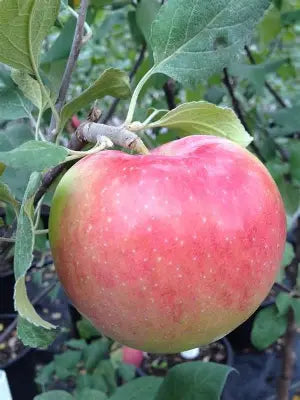Riverdene Garden Centre
Prairie Magic Apple
Prairie Magic Apple
Couldn't load pickup availability
Prairie Magic Apple (Malus ‘Prairie Magic’) Care Guide
Overview:
Prairie Magic is a hardy, early-season apple variety developed for northern climates, producing crisp, sweet-tart fruit with a red overlay on green skin.
It is valued for its adaptability, moderate growth, and attractive fruit for fresh eating, baking, and sauces.
1. Planting & Growing Conditions
-
Hardiness Zone: Suited for zone ~3b and similar cold climates.
-
Mature Size: Approximately 15 ft × 15 ft in height and spread (semi-dwarf growth habit)
-
Habit: Rounded, moderately spreading branching structure
-
Light Requirements: Full sun for best fruiting and health
-
Soil: Well-drained soil is essential (does not tolerate soggy or waterlogged soils)
-
Site Considerations: A wind-sheltered location is preferred to reduce stress on blossoms and fruit sets
2. Flowering & Fruit
-
Bloom Time: Late May to early June
-
Fruit Ripening: Late August
-
Fruit Description:
• Size: large (≈3–3.5 inches / 7–8 cm)
• Skin: Green base with a red overlay (blush)
• Flesh: Crisp, juicy, good for fresh eating, pies, sauces, jams -
Storage / Shelf Life: Keeps 2–3 months under refrigeration conditions
-
Bearing Age: Begins producing fruit at about 3 years old
3. Pollination & Fruit Set
-
Self-Fertility: Somewhat self-fruiting, but yields are significantly better with a pollinator.
-
Pollinators: Suitable pollinators include varieties like Honeycrisp, Gala, or Liberty.
-
Proximity: For effective cross-pollination, plant pollinators within about 200 ft (or closer)
4. Watering & Establishment
-
First 1–2 Years: Water deeply and regularly during dry spells to help root establishment
-
Once Established: Drought-tolerant to a degree, but supplemental watering in dry periods improves fruit set and tree health
-
Mulching: Use 2–3 inches of organic mulch around the base (keeping it off the trunk) to retain moisture and stabilize soil temperatures
5. Fertilizing
-
Apply a balanced, slow-release fertilizer in early spring before growth resumes
-
Use compost or well-rotted organic matter at planting to help improve soil structure
-
Avoid over-fertilization—especially high nitrogen—as it can lead to excessive vegetative growth and reduce fruit quality
6. Pruning & Maintenance
-
Best Time: Late winter to early spring while tree is dormant
-
Pruning Practices:
• Remove dead, diseased, or crossing branches
• Thin inner canopy to allow light and air penetration
• Maintain a good scaffold structure
• Avoid heavy pruning in late summer, as that may stress the tree or reduce fruiting
7. Pest & Disease Considerations
-
Prairie Magic is considered a reasonably hardy variety, but like all apple trees, it's susceptible to:
• Fire blight
• Apple scab
• Codling moth
• Aphids, leaf spot, rust, and other common orchard pests/diseases -
Best Practices for Management:
• Maintain good air circulation
• Prune properly and remove fallen fruit and leaves
• Monitor and apply protective treatments when needed using integrated pest management
8. Winter & Cold Protection
-
Well-suited for cold climates; late frost or sunscald may damage young trees — use protective wraps or shelters when young if needed
-
Apply mulch over the root zone in late fall to buffer against freeze-thaw cycles
9. Harvest & Use
-
Harvest when fruit attains full color and yields to gentle twist
-
Excellent for fresh eating, baking, sauces, and home canning
-
Handle carefully to avoid bruising; store in cool, humid conditions for best shelf life
Photo from Jeffries Nurseries
Share


